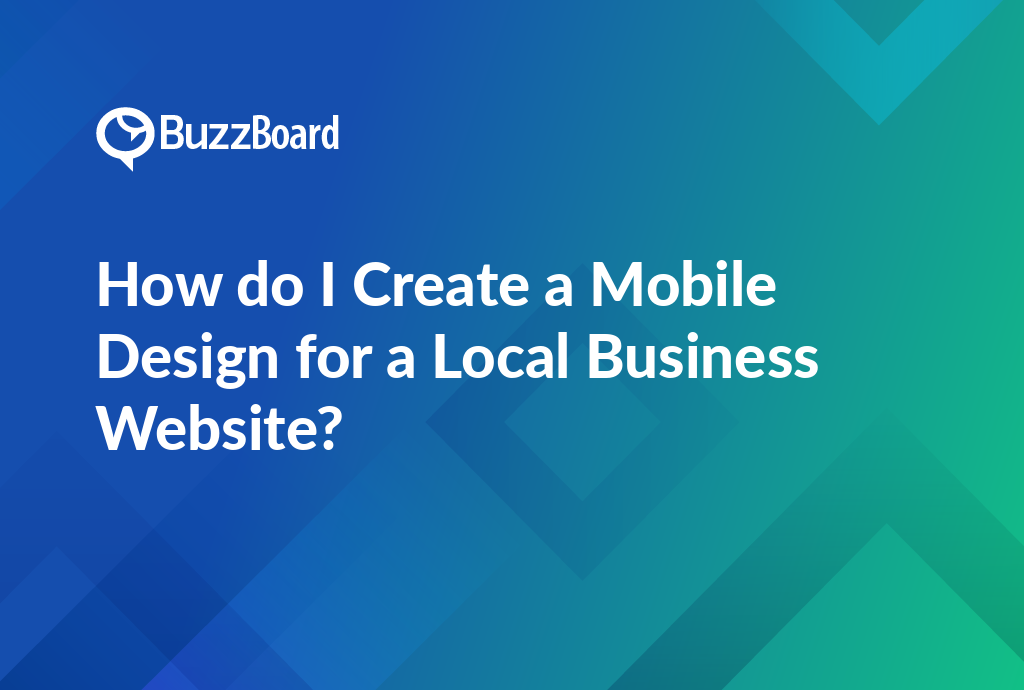How to Create a Mobile-Friendly Design for a Local Business Website
To create a mobile-friendly design for a local business website, follow these essential steps: First, identify your target audience and their mobile behavior. Then, use a responsive design approach to ensure your website adapts to different screen sizes and devices. Next, prioritize content and simplify navigation to make it easy for mobile users to find what they need. Finally, test and optimize your design to ensure a seamless user experience across all devices.
The Impact of Mobile Design on Local Businesses
In the digital era, it’s crucial for local businesses to adopt effective mobile designs for their websites. As a digital agency, you grasp this need and are committed to helping local business clients flourish in the continuously evolving digital landscape.
Mobile design significantly enhances the user experience on mobile devices, increasingly vital as people heavily depend on their smartphones for web browsing. According to reports, around 50% of global web traffic originates from mobile users. Now, visualize your clients’ websites not being mobile-friendly; they could be potentially missing out on half of their potential online traffic.
Implementing a responsive and mobile-friendly design for local businesses’ websites has transitioned from a luxury to a necessity. Google prioritizes mobile-friendly websites in its search results, thereby boosting the visibility and reach of local businesses. A mobile-optimized website can provide a competitive edge for local businesses in capturing local traffic and increasing footfall to their physical stores.
As web professionals and a digital agency, your role is essential in assisting local businesses to reach their target audience through a responsive mobile design. It entails more than just crafting a website that “fits” into a mobile screen; it’s about creating a positive user experience that directly influences audience engagement and conversion rates.
To adopt a mobile-friendly design for your local business clients, consider easy navigation, swift page loading speeds, readable text without zooming, and straightforward access to business information like location, contacts, and so on.
Encourage your local business clients to embrace this digital revolution by highlighting the advantages of a mobile-friendly design, coupled with your expertise in executing it efficiently. For assistance with designing a mobile-friendly website that can amplify the reach and visibility of your local business clients, let’s redefine the digital experience together.
Key Mobile Design Considerations for Web Professionals
A website is an indispensable asset for small businesses seeking to establish a strong market presence. As web design professionals, you, digital agencies, are the preferred choice for local businesses looking to optimize their online presence. However, crafting websites for local businesses involves more than just creating visually appealing user interfaces. One vital element is ensuring a seamless mobile experience, which has become a crucial aspect of web design.
The widespread use of smartphones has made mobile design for local business websites essential. According to a Pew Research report, nearly 96 percent of Americans own a smartphone, highlighting the importance of mobile-friendly design. With the majority of online browsing now taking place on mobile devices, it’s essential to ensure that your design provides an optimal user experience across various devices and screen sizes.
A mobile-friendly design must be intuitive, providing optimal navigation and load speed. This demand for mobile optimization affords considerable opportunities for discerning digital agencies to differentiate themselves and deliver exceptional results for their clients. To maximize these opportunities and deliver a website that meets local business clients’ needs, certain key factors must be observed.
First and foremost, making the website mobile responsive is paramount. This means ensuring that the website adjusts suitably to various screen sizes, providing a pleasant browsing experience for users. This is crucial, as neglecting mobile design can lead to adverse consequences for local businesses, potentially affecting their visibility and deterring potential customers who primarily use mobile devices for online browsing.
In addition to mobile responsiveness, other key factors to consider include:
- Fast loading speeds: A slow-loading website can lead to high bounce rates and negatively impact user experience.
- Intuitive navigation: A clear and easy-to-use navigation menu is essential for users to find what they’re looking for quickly and efficiently.
- Responsive images and content: Ensuring that images and content are optimized for mobile devices is crucial for providing a seamless user experience.
- Accessibility: Ensuring that the website is accessible to users with disabilities is not only a legal requirement but also a moral obligation.
By prioritizing these key factors, digital agencies can deliver a website that meets the unique needs of local businesses and sets them apart from their competitors. Furthermore, by integrating mobile-friendly interfaces and functionalities in your design strategy, you can elevate the value of your digital marketing services to these small businesses.
As a web professional, your role extends beyond service provision; it’s about steering your clients to success. In tackling these challenges, be innovative, flexible, and, most importantly, prioritize your client’s unique requirements. By doing so, you can help local businesses establish a strong online presence, drive more traffic and conversions, and ultimately achieve their business goals.
Mobile website design is no longer a nice-to-have, but a must-have for local businesses. By prioritizing mobile-friendly design, digital agencies can deliver exceptional results for their clients, set themselves apart from competitors, and establish themselves as leaders in the industry. Remember, the key to success lies in understanding the unique needs of local businesses and delivering a website that meets those needs, providing a seamless mobile experience that drives results.
The Role of Mobile-Friendly Design in Modern Digital Marketing Strategies
For any web professional or digital agency targeting local business clients, mobile-friendly design should be a top priority in your digital marketing strategy. A user-friendly, mobile design is an invaluable tool in enabling small businesses to connect with their target audiences in a personal and accessible manner, ultimately driving conversions and growth. In today’s digital landscape, a mobile-friendly design is no longer a nice-to-have, but a must-have for any business looking to remain competitive.
The expectation for an optimum mobile experience is higher than ever, and Google’s transition to mobile-first indexing has made it more crucial than ever to adapt your site’s design to be mobile-friendly. This means that your digital agency must prioritize mobile-friendliness when designing and developing websites for local businesses. By doing so, you can meet Google’s standards and increase your chances of ranking favorably in search results, ultimately driving more traffic and conversions to your clients’ websites.
Local businesses can particularly leverage mobile-friendly design to their advantage. When a local customer searches for a product or service on their mobile device, a mobile-friendly, geo-optimized site can put them at the forefront of the search results. This not only increases visibility but also offers convenience to users, making it more likely that they will engage with your client’s website and ultimately convert.
For instance, a customer searching for a local plumber on their mobile device will likely click on the first mobile-optimized, local website they find. If your client’s site isn’t optimized for mobile, they might be missing out on potential business opportunities. By emphasizing the importance of mobile-friendliness, you can help your clients avoid this common mistake and capitalize on the growing demand for mobile-friendly experiences.
In addition to its impact on search engine rankings, mobile design also offers a range of benefits that can enhance the user experience and drive engagement. Mobile design allows for more flexibility, more interactivity, and generally a more immersive experience. By incorporating features such as responsive design, touch-friendly interfaces, and mobile-specific content, you can create a website that is tailored to the unique needs and behaviors of mobile users.
By explaining these benefits to your small business clients and emphasizing the value that mobile design brings, you can showcase the full range of your services and demonstrate your expertise in digital marketing. This can be a significant selling point for your digital marketing agency, setting you apart from competitors and establishing your agency as a trusted partner for local businesses.
Ultimately, demonstrating an understanding of these strategies—coupled with an awareness of both local and global trends—can be a significant selling point for your digital marketing agency. By guiding your local business clients into the modern age and helping them dominate their local markets, you can establish your agency as a leader in the industry and drive long-term growth and success for your clients.
Examples of Successful Mobile Design
In today’s digital era, the value of mobile design for local business websites is paramount. It’s not merely about drawing users to your site but keeping them engaged and converting them into customers. We present four examples that demonstrate how digital agencies have successfully implemented mobile design for their local business clients, resulting in enhanced engagement and sales.
These case studies highlight the critical part of mobile design in boosting engagement and sales for local business clients. So, what actions can digital marketing agencies implement to replicate this success? They need to stay abreast of the current web professional guidelines to ensure the effectiveness of their mobile design strategies.
For instance, digital agencies should adopt responsive design, fast page loads, and easy navigation to provide a user-friendly experience. Additionally, infusing SEO strategies into the design process can result in more organic traffic and ultimately, heightened sales.
Practical Tips for Creating an Effective Mobile Design
Winning local business clients requires more than just urging them to establish a mobile-friendly online presence. As a digital agency, you’re tasked with not only explaining the importance of mobile design but also providing a comprehensive guide on how to achieve it. This involves illustrating the “how” and “why” behind mobile design for a local business site, and empowering your clients with actionable tips to enhance their online presence.
To begin, it’s essential to educate your clients on the significance of UX/UI principles. UX, or User Experience, refers to the overall encounter a user has when interacting with a website. This encompasses every aspect of the user’s journey, from the moment they land on the site to the moment they leave. In contrast, UI or User Interface focuses on the aesthetic components that augment this experience, such as typography, color schemes, and layout. The ultimate goal is to create a seamless, pleasurable, and efficient experience that encourages users to return and engage with the site.
A crucial first step in devising effective mobile design is incorporating a responsive website. Responsiveness implies that no matter the device (laptops, tablets, smartphones), the website’s visual and cardinal elements are reconfigured to accommodate the user’s screen. This ensures that the website looks and functions optimally across various devices, providing a consistent user experience regardless of how users access the site.
Simplicity is another key aspect of mobile design. Mobile screens are more compact, and users frequently browse on the go. Excessively intricate designs can bewilder users and compromise navigation ease. To overcome this, it’s essential to maintain basic menus, opt for distinct CTA (Call-to-Action) buttons, and ensure text readability without necessitating zooming. This will enable users to quickly and easily find the information they need, increasing the chances of conversion.
Rapid website loads are also crucial for a positive mobile user experience. Slow-loading websites can lead to frustration, abandonment, and a negative perception of the brand. To ensure your website loads quickly, employ Google’s Test My Site tool to assess your website’s speed. This will provide you with a comprehensive report highlighting areas for improvement, such as image compression, code optimization, and content delivery network (CDN) implementation.
In addition to these technical considerations, it’s essential to prioritize content and messaging. Mobile users are often on-the-go, and their attention span is shorter than ever. To capture their attention, focus on concise, clear, and relevant messaging that resonates with your target audience. Use high-quality images and videos to break up text and make the content more engaging.
Another important aspect of mobile design is the use of mobile-specific features. These can include features such as click-to-call buttons, location-based services, and mobile-specific CTAs. By incorporating these features, you can create a more seamless and personalized experience for mobile users, increasing the chances of conversion and engagement.
As a web professional in digital marketing, you’ll rapidly recognize the importance of providing a superior mobile user experience. By centering on these actionable tips, you can assist your clients in augmenting their local business site while increasing user engagement and conversions. By prioritizing responsiveness, simplicity, rapid website loads, and mobile-specific features, you can create a mobile design that not only looks great but also drives results.
Conclusion
Creating a mobile design for a local business website is crucial in today’s digital age. With the majority of users accessing the internet through their mobile devices, a mobile-friendly website is no longer a luxury, but a necessity. By following the steps outlined in this article, local businesses can ensure that their website is optimized for mobile devices, providing a seamless user experience for their customers.
This includes considering the importance of a responsive design, prioritizing content, and incorporating essential features such as click-to-call buttons and location-based services. By doing so, local businesses can increase their online visibility, drive more traffic to their website, and ultimately, boost their sales and revenue. By prioritizing mobile design, local businesses can stay ahead of the competition and thrive in the digital landscape.








